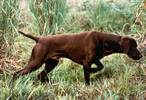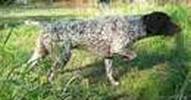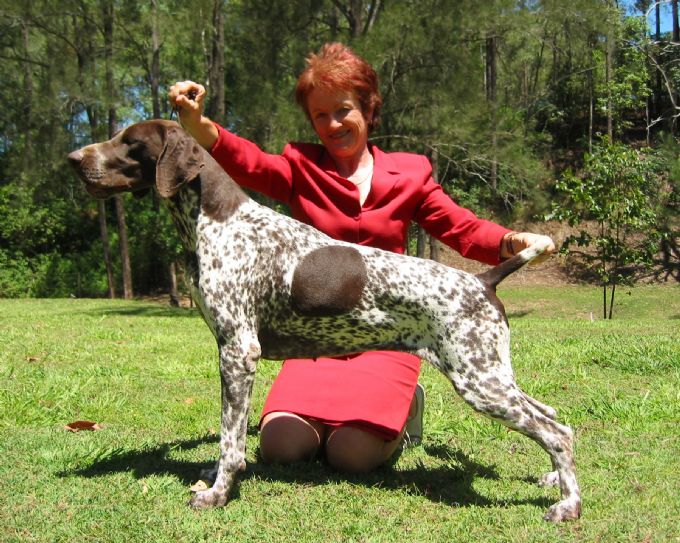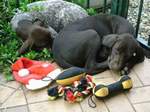THE BREED
THE BREED STANDARD: GERMAN SHORTHAIRED POINTER
| Group: |
Group 3 (Gundogs) |
| History: |
|
| General Appearance: |
A dog of noble and balanced appearance, the conformation of which ensures strength, endurance and speed. Proud attitude, smooth outlines, lean head, well carried tail, firm shiny coat and well reaching, harmonious strides emphasise its nobility. |
| Characteristics: |
Not Specified. |
| Temperament: |
Firm, balanced, reliable, restrained temperament. Neither nervous, nor shy or aggressive. |
| Head And Skull: |
Lean, well defined, neither too light nor too heavy; as to strength and length it matches the substance and the sex of the dog.
Skull: Moderately wide, flatly rounded, scarcely pronounced occipital bone, front furrow not too deep, noticeably developed superciliary ridges.
Stop: Moderately developed
Foreface
Nose: Somewhat protruding. Nostrils sufficiently wide, broad and mobile. Basically brown, however black in black or black roan dogs. A flesh-coloured or spotted nose is only permissible in dogs with white as a basic colour.
Muzzle: Long, broad, deep and strong in order to enable the dog's correct carrying of game. Viewed from the side the nasal bridge shows a slight curvature in all transitions from a nobly constructed ram's nose to a slight rise above the straight line, more prominent in the males. A totally straight nasal bridge, although still acceptable, is less attractive; a concave bridge (dish-face) is a serious fault.
Flews: Tight fitting, not too pendulous, good pigmentation. The naso-labial line slopes almost vertically and then continues in a flat arch to the moderately pronounced corner of the lips.
Cheeks: Strong, well muscled. |
| Eyes: |
Of medium size, neither protruding nor deep set. The ideal colour is dark brown. Eyelids tight fitting. |
| Ears: |
Moderately long, set on high and broad, flat and without twisting hanging down close to the head, bluntly rounded at the tip. Neither too fleshy nor too thin. When brought forward they should reach to approximately the corner of the lips. |
| Mouth: |
Strong jaws with a perfect, regular scissor bite. The upper incisors should reach over the lower incisors without a gap and the teeth should be positioned vertically in the jaws. 42 sound teeth, in accordance with the teeth formula. |
| Neck: |
Length in harmony with the general appearance of the dog, progressively thickening towards the body. Very muscular and slightly crested nape. Tight fitting skin of throat. |
| Forequarters: |
General appearance: Viewed from the front, straight and parallel; viewed from the side, the legs are well placed under the body.
Shoulders: Shoulder blades well laid back, well attached to chest, and strongly muscled. Shoulder blade and upper arm well angulated.
Upper arm: As long as possible, well muscled and dry.
Elbow: Close but not too tight to body, neither turned in or out, well set back.
Forearm: Straight and sufficiently muscled. Strong bone, not too coarse.
Pastern joint: Strong
Pastern: Minimal angulation of pastern and forearm, never standing upright. |
| Body: |
Topline: Straight and slightly sloping.
Withers: Well defined
Back: Firm and muscular. Vertebral processes should be covered by muscles.
Loin: Short, broad, muscular, straight or slightly arched. Transition from back to loin tight and well knit.
Croup: Broad and long enough, not abruptly slanting, but slightly slanting towards the tail, well muscled.
Chest: Somewhat deeper than broad with well defined forechest, with the sternum reaching back as far as possible. Sternum and elbow joint on the same level. Ribs well sprung, neither flat nor barrel-shaped. False ribs reaching well down.
Underline: With elegant arch, slightly tucked up towards rear, dry. |
| Hindquarters: |
General appearance: Viewed from behind straight and parallel. Good angulation in stifles and hocks, strong bone.
Upper thigh: Long, broad and muscular, with good angulation between pelvis and femur.
Stifle: Strong, with good angulation of upper and lower thigh.
Lower thigh: Long, muscular with clearly visible tendons. Good angulation between lower thigh and hocks.
Hock joint: Strong.
Hocks: Strong, vertical. |
| Feet: |
Round to spoon shaped, with well tight and adequately arched toes. Strong toenails. Tough, resistant pads. Feet set parallel, neither turned in nor out, in stance as well as movement. |
| Tail: |
Set high, strong at the root and then tapering, of medium length. About halfway docked for hunting purposes. At rest hanging down; in movement horizontal, neither carried too high above the backline nor extremely bent. (In countries where the tail docking is prohibited by law, the tail can remain in its natural shape. It should reach as far as the hocks and be carried straight or slightly sabre tail fashion). |
| Gait/Movement: |
Well extended strides, with forceful propulsion from the hindquarters and adequate reach of the forelimbs. Front and hind legs moving straight and parallel. The dog is carrying himself in a proud attitude. Pacing gait is not desirable. |
| Coat: |
Skin: Close and tight, not wrinkly.
Texture: Short and dense, rough and hard to the touch. Somewhat thinner and shorter on the head and ears, not remarkably longer at the underside of the tail. Should cover the whole body. |
| Colour: |
Solid brown, without markings.
Brown with small white or flecked markings at chest and legs.
Dark brown roan, with brown head, brown patches or specks. The basic colour of such a dog is not brown mixed with white or white with brown, but the coat shows such an even intensive mixture of brown and white which results in that kind of inconspicuous exterior of the dog ever so valuable for the practical hunt. At the inner sides of the hindlegs as well as the tip of the tail the colour is often lighter.
Light brown roan with brown head, brown patches, specks or without patches. In this colouring the brown hairs are fewer, the white hairs are predominant.
White with brown head markings, brown patches or specks.
Black colour in the same nuances as the brown, respectively the brown roan colours.
Yellow tan markings are permissible.
Blaze, fleck and speckles flews are permissible. |
| Sizes: |
Height at the withers:
Dogs 62-66 cms
Bitches 58-63 cms |
| Faults: |
Any departure from the foregoing points should be considered a fault and the seriousness with which the fault should be regarded should be in exact proportion to its degree and its effect upon the health and welfare of the dog, and on the dog?s ability to perform its traditional work.
Faults in attitude, not according or typical to gender.
Muzzle too short
Flews too heavy or too thin
From the total of 4 PM 1 and 2 m3 only two teeth may be missing.
Eyes too light. Yellowish, bird of prey eyes.
Ears too long, too short, too heavy, set on too narrow or twisted.
Loose skin at throat.
Slight roach back.
Rump (croup) too short.
Chest too deep.
Tail strongly bent or carried too high above the topline.
Elbows turned in or out. Feet turned in or out. Forelegs standing close or wide.
Hindquarters too straight.
Slightly bow-legged, slightly cow-hocked or close hocks.
SERIOUS FAULTS
Clumsy, lymphatic, coarse conformation.
Marked stop.
Flesh-coloured or flecked nose (except when basic colour of coat is white).Snipy muzzle, concave bridge of the nose (dishface).
Pincer bite or partial pincer bite.
Distinct roach back, slight swayback.
Considerable lack in depth of chest. Poorly developed forechest. Ribs too flat or barrel shaped.
Distinctly turned in or out elbows.
Weak and down on pasterns.
Pastern totally vertical
Distinctly cow-hocked or bow-legged, in stance as well as in movement.
Overbuilt hindquarters.
Flat feet.
Spread toes.
Clumsy gait.
Deviation of more than 2 cm from the given height at the withers.
DISQUALIFYING FAULTS
Distinctly non-typical gender characteristics.
Absence of more than 2 teeth from the total of 4 PM1 and 2M3. Absence of 1 tooth or more other than PM1 and M3.
Non visible teeth have to be considered as missing.
Overshot or undershot bite, wry mouth as well as all intergrades.
Any surplus teeth arranged outside the dental arch.
Cleft palate and hare lip.
Excessively loose eyelids, ectropian, entropian, distichiasis (double row of eyelashes).
Excessive swayback, malformation of the spine.
Any malformation of the chest, e.g. clipped sternum (short sternum blending abruptly into the abdominal line).
Rear dewclaws with or without bony skeleton.
Weak character. |
| Notes: |
Male animals should have two apparently normal testicles fully descended into the scrotum. |
Last Updated: 2 Jul 2009
|
BACKGROUND
Originally bred as a hunting dog, the German Shorthaired Pointer is one of the world's
most popular dogs. This active breed was first developed as early as the 17th century
in Germany and Austria by crossing the Spanish Pointer with other European
scent hounds. Later the English Foxhound was included for scenting ability and
endurance, together with the English Pointer to achieve elegance in working
style. The aim was to produce an all purpose dog to hunt fur and feather, while
working well on land and in water. The result was a loyal, active dog capable
of hunting game throughout Europe. The dog was first registered by the German
Kennel Club in 1872 and its popularity continues to grow around the globe.
AVERAGE LIFESPAN BACKGROUND

This robust dog normally lives to approximately 12-14 years of age.
BREED PERSONALITY, CHARACTERISTICS & TEMPERAMENT
German Shorthaired Pointers are gentle, active dogs that love human
company, including children. They are an intelligent breed, making them
very trainable. Their loving disposition makes them an ideal companion for dog
lovers of all ages.
COMPATIBILITY WITH OTHER PETS
These agreeable dogs will get along with most pets in the home when raised
together from an early age. Like most hunting breeds, they may
enjoy chasing games with smaller pets.
CARE REQUIREMENTS
The German Shorthaired Pointer's coat requires minimal grooming. Brushing
weekly and bathing as required with a soap-free shampoo is all that is
needed, so as not to remove natural coat oils. Like most hunting dogs, this
breed needs plenty of exercise to stay in peak condition, so regular walks
or runs are necessary. While GSPs have a gentle, loving nature, they can
be easily excited and should be supervised around young children, as a usual
safety requirement with all dogs.
IDEAL OWNERS
Being an active dog, the German Shorthaired Pointer needs space to explore
and is best suited to a home environment with a large fully-fenced backyard.
Owners must be prepared for regular exercise sessions to occupy this intelligent breed.
IN CONCLUSION
If you want more information about this loyal animal we look forward to hearing from you.
DECISION TIME
Before making a decision on getting a pup, here are some point to consider:
What do you need to consider if you are thinking of buying a puppy?
Lifestyle; Time Available; Training Requirements; Lifetime Commitment
What should you ask the breeder? View parents; View litter; View environment
How do you check if the breeder is reputable? Registered Breeder Only; Listed With Local Canine Club
What to ask your vet prior to buying a puppy: Puppy Care; Costs
CANINE CLUBS
Australian Capital Territory
ACT Canine Association Inc
PO Box 815
Dickson, ACT 2602
Tel: 02 6241 4404
Fax: 02 6241 1129
Website: www.actca.asn.au
|
|
New South Wales
Dogs NSW
PO Box 632
St Marys, NSW 1790
Tel: 02 9834 3022 or 1300 728 022 (NSW only)
Fax: 02 9834 3872
Website: www.dogsnsw.org.au
|
Northern Territory
The North Australian Canine Association Inc
PO Box 37521
Winnellie, NT 0821
Tel: 08 8984 3570
Fax: 08 8984 3409
Website: www.users.bigpond.com/naca1/
|
|
Queensland
Dogs QLD
PO Box 1136
Mt Ommaney, Qld 4074
Tel: 07 3252 2661
Fax: 07 3252 3864
Website: www.dogsqld.org.au
|
South Australia
South Australian Canine Association Inc
PO Box 844
Prospect East, SA 5082
Tel: 08 8349 4797
Fax: 08 8262 5751
Website: www.saca.caninenet.com
|
|
Tasmania
Tasmanian Canine Association Inc
The Rothman Building
PO Box 116
Glenorchy, Tas 7010
Tel: 03 6272 9443
Fax: 03 6273 0844
Website: www.tca.freeservers.com
|
Victoria
Victorian Canine Association
Locked Bag K9
Cranbourne, Vic 3977
Tel: 03 9788 2500
Fax: 03 9788 2599
Website: www.vca.org.au
|
|
Western Australia
Canine Association of Western Australia Inc
PO Box 1404
Canning Vale, WA 6970
Tel: 08 9455 1188
Fax: 08 9455 1190
Website: www.cawa.asn.au
|
|
|





